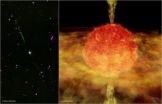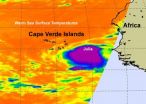(Press-News.org) ROCKVILLE, Maryland, September 14, 2010 – Neuralstem, Inc. (NYSE Amex: CUR) announced that its spinal cord stem cells survived in rat brains affected by stroke and differentiated predominantly into neurons. The transplanted animals showed significant improvement in some motor skill and strength measurements. The study entitled, "Intracerebral Implantation of Adherent Human Neural Stem Cells To Reverse Motor Deficits in Chronic Stroke Rats," was presented earlier today by senior study author, Dr. Shinn-Zong Lin, M.D., Ph.D., at the Stem Cells USA & Regenerative Medicine Conference (http://www.terrapinn.com/2010/stemcellsusa/conf.stm), in Philadelphia, PA. Dr. Lin is a Professor of Neurosurgery and Vice Superintendent at China Medical University Hospital of Taiwan.
"This animal study shows the potential promise of this cell line in treating post-stroke symptoms," Dr. Lin commented. "Four weeks after transplantation, the rats treated with Neuralstem's cells showed significantly decreased asymmetric body swing, increased vertical movements and increased grip strength, compared with the control group."
"Dr. Lin's findings represent a significant milestone for Neuralstem. They are the first to show how our human spinal cord-derived stem cell product, NSI-566RSC, currently in a clinical trial for ALS, and which we expect to be in another clinical trial for spinal cord injury, also works in the stroke brain," said Dr. Karl Johe, Ph.D., Neuralstem's Chief Scientific Officer and Chairman of the Board of Directors. "Our proposed treatment for paralysis due to stroke will involve transplantation near the motor tracts close to the stroke lesion in the brain in order to promote regeneration and repair. While the trial protocol for ALS and chronic spinal cord injury involves transplantation into the spinal cord, and that for stroke will involve transplantation into the brain, we are nevertheless targeting the circuitry that controls motor function in each indication. We are developing clinical programs for stroke in both the U.S. and Taiwan, and hope to start our first trial in 2011."
INFORMATION:
About Neuralstem
Neuralstem's patented technology enables the ability to produce neural stem cells of the human brain and spinal cord in commercial quantities, and the ability to control the differentiation of these cells constitutively into mature, physiologically relevant human neurons and glia. Neuralstem is in a FDA-approved Phase I safety clinical trial for Amyotrophic Lateral Sclerosis (ALS), often referred to as Lou Gehrig's disease.
In addition to ALS, the company is also targeting major central nervous system diseases, including traumatic spinal cord injury, ischemic spastic paraplegia, and Huntington's disease. The company has also submitted an IND (Investigational New Drug) application to the FDA for a Phase I safety trial in chronic spinal cord injury.
Through its proprietary screening technology, Neuralstem has discovered and patented compounds that may stimulate the brain's capacity to generate new neurons, possibly reversing the pathologies of some central nervous system conditions. Neuralstem plans to initiate clinical trials with its lead compound to treat major depression and potentially other diseases, such as schizophrenia, Alzheimer's disease, traumatic brain injury, posttraumatic stress syndrome, and stroke.
For more information, please go to www.neuralstem.com
Cautionary Statement Regarding Forward Looking Information
This news release may contain forward-looking statements made pursuant to the "safe harbor" provisions of the Private Securities Litigation Reform Act of 1995. Investors are cautioned that such forward-looking statements in this press release regarding potential applications of Neuralstem's technologies constitute forward-looking statements that involve risks and uncertainties, including, without limitation, risks inherent in the development and commercialization of potential products, uncertainty of clinical trial results or regulatory approvals or clearances, need for future capital, dependence upon collaborators and maintenance of our intellectual property rights. Actual results may differ materially from the results anticipated in these forward-looking statements. Additional information on potential factors that could affect our results and other risks and uncertainties are detailed from time to time in Neuralstem's periodic reports, including the annual report on Form 10-K for the year ended December 31, 2009, and in its quarterly report on Form 10-Q for the period ended June 30, 2010.
An astronomer may have caught a cannibalistic star in the act of devouring a companion and making a second generation of exoplanets from the resulting orbiting disk.
Using data from NASA's Chandra X-ray Observatory, Joel Kastner, professor at Rochester Institute of Technology, has found evidence that a variable star in the constellation of Pisces, BP Piscium, is not the young star it appears to be, but is more likely a one billion-year-old red giant that has gobbled up a star or planet in its vicinity.
The star's extreme properties have puzzled astronomers since Kastner ...
"The IFFS's 'Surveillance 2010' report, compiled by Professor Ian Cooke and published on 14 September 2010, illustrates this for over 100 countries. The survey highlights how widely assisted reproductive technologies (ART) are being used and how different cultures are regulating services in different ways. In most countries there is no state or insurance support, so these services are costly and frequently beyond the reach of many families. In some countries access to donor gametes is denied or supply is limited.
To address the safety of patients that seek treatment abroad, ...
Low Adherence with Regular Fecal Occult Blood Test Screening Among Insured Patients
In a large U.S. health plan, nearly one-half of patients who initiated biennial fecal occult blood test (FOBT) screening did not adhere to subsequent colorectal screening in the ensuing 2-year period, compromising the effectiveness of the screening endeavor which hinges on regular screening. Analyzing data on 11,110 patients enrolled in a Washington State health plan who completed an FOBT during the baseline period (2000-2001), researchers found 47 percent received no colorectal screening ...
Farming practices have a significant impact on the diversity of beneficial microbial fungi known to play important roles in crop productivity, soil recovery and maintenance of healthy ecosystems, according to new research published today (14 September 2010) in the journal Environmental Microbiology. The conclusions could have important implications for the way humans manage the agricultural landscape and tackle food security issues.
The study was led by Dr Christopher van der Gast at the Centre for Ecology & Hydrology (CEH), UK and Dr Gary Bending from the University ...
A medicine widely used to treat attention-deficit/hyperactivity disorder (ADHD) also provides long-term relief from the attention and behavior changes that affect many childhood cancer survivors, according to a multicenter trial led by St. Jude Children's Research Hospital investigators.
Researchers reported that one year after starting the drug methylphenidate, young cancer survivors scored better on tests of sustained attention and other measures of attention, social skills and behavior than did a similar group of unmedicated survivors. While taking methylphenidate, ...
NASA Satellites have noticed two distinct features in Igor that both indicate how powerful he has become, icy cold, high cloud tops and very heavy rainfall. NASA's Aqua and TRMM satellites have provided that insight to forecasters who are predicting Igor's next move as a powerful Category 4 Hurricane.
Last week, Igor was a tropical storm who faded into a tropical depression. The National Hurricane Center had forecast that over the weekend Igor would approach more favorable conditions (low wind shear and warm sea surface temperatures) causing it to strengthen into a hurricane ...
Tropical Depression 12 was born in the far eastern Atlantic Ocean yesterday, Sept. 12 and two NASA satellites saw factors that indicated she would later strengthen into Tropical Storm Julia. Infrared imagery from NASA's Aqua satellite revealed strong convection in its center that powered the storm into tropical storm status by 11 p.m. EDT. NASA's TRMM satellite indicated very heavy rainfall from that strong area of convection.
The Atmospheric Infrared Sounder (AIRS) instrument that flies on NASA's Aqua satellite gives scientists and meteorologists clues about how a tropical ...
COLUMBUS, Ohio – Researchers at the Ohio State University Comprehensive Cancer Center-Arthur G. James Cancer Hospital and Richard J. Solove Research Institute (OSUCCC-James) have identified an experimental agent that targets chronic lymphocytic leukemia and perhaps other proliferative disorders of lymphocytes.
Their study shows that the small-molecule inhibitor CAL-101 directly promotes cell death by apoptosis in chronic lymphocytic leukemia (CLL) cells and disrupts several external survival pathways needed for CLL cell viability and proliferation.
The agent blocks ...
Washington, DC, SEPTEMBER 14, 2010– A widely prescribed class of drugs is highly effective in reducing common bone fractures in people with osteoporosis, but an expert panel announced today that these same drugs – when used long term – may be related to unusual but serious fractures of the thigh bone. In the most comprehensive scientific report to date on the topic, the task force reviewed 310 cases of "atypical femur fractures," and found that 94 percent (291) of patients had taken the drugs, most for more than five years. The task force members emphasized that atypical ...
A set of studies released in this month's special issue of The Elementary School Journal reveals the powerful effect that the coaching of teachers can have on both teachers and students.
"Many in the field have trusted that intuitive feeling that putting a knowledgeable coach in a classroom to work with a teacher will result in improved teacher practices and increased student learning," write the issue's guest editors, Misty Sailors of The University of Texas at San Antonio and Nancy L. Shanklin of University of Colorado, Denver. "The jury of these researchers and the ...


